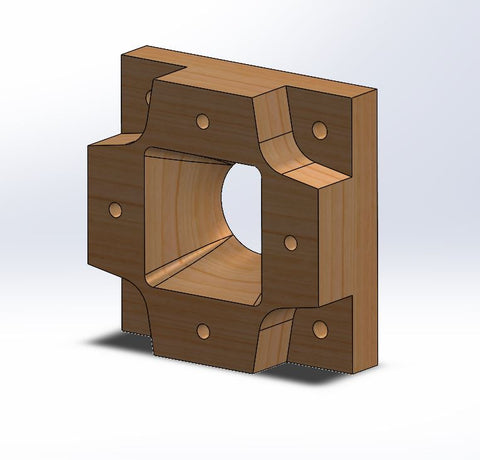In this blog post I would like to introduce a new DIY front horn that continues on from the Summer Rain horn. The Sabourin Horn is simpler to make and easier to assemble. It also uses my ES horn flare curvature with the exception of the final wrap around at the horn mouth.
I’ve featured some of the details of this blog post on a YouTube video which can be viewed here.
To purchase the plans click here.
Advantage compare to old Summer Rain Horn
- Mitre Corner joints for easier assembly and cleaner appearance from the rear
- Improved three stage horn flare geometry
- Six size configurations depending on your application
- Can be used with compression drivers if using the throat adapter
- 200Hz and 300Hz variants
- Easy design changes to scale the size up or down
What's included in the plans
- All six size variants
- PDF assembly and detail drawings
- 3D CAD Files for horn assemblies (.iges format)
- Suggested fullrange driver plan using Fostex FE108EZ 4" fullrange driver
- Suggested compression driver plan using B&C DCX-464 (requires throat adapter)
- 3D CAD file for throat adapter converting 2" (50.1mm) square to 1.40" round to mount compression driver.
- Video walkthrough on assembly and construction (YouTube Video)
Design
The three stage horn flare geometry closely follows the ES Curvature for optimum sound quality. Maximum deviation from the curve is held at less than 8mm along each flare. (see red arrow)

Wide Throat Angle
The wide throat angle of 16 degrees keeps parallels wall resonances to a minimum. These acoustical standing waves can be setup if the angle was less than 8 degrees., so 16 degrees provides a 'wide' margin of safety.

Wide Mouth Angle
The wide 71 degree angle at the horn mouth insures there is little reflection back down the horn axially. This also minimizes edge diffraction off the horn mouth edge.

Miter Corner Joints
Miter corner joints allow for a strong bond between the vertical and horizontal walls. This also provides a clean appearance at the rear of the horn. The miter angles are compound cuts which can be done on a table saw. In other words the use of a CNC machine is not required.




Below is a detail drawing of one horn sections. The drawing details out the sizes and angles for each cut.

The drawing shows a 15.5 degree miter, with a 47.2 degree bevel. The diagram below provides guidance...

These angles can be cut on a cross cut saw...

For accurate saw setup it is recommended to use a digital angle finder...

Support Stand
Included in the plans is the support stand.


Design Variants
The plans include six size variations to suit your needs. Below is a product matrix which highlights the various sizes.
| Product Matrix --- Sabourin Horn Series | ||||||
| Horn Number | Horn Throat Size (inch) | Throat Size (mm) | Mouth Size (inch) | Mouth Size (mm) | Low Frequency Cutoff (Fc) | |
| 1293 | 2" (1.4" with adapter) | 50mm | 19.69" | 500mm | 300Hz | |
| 1294 | 2.992" | 76mm | 20.67" | 525mm | 300Hz | |
| 1295 | 3.397" | 100mm | 21.62" | 549mm | 300Hz | |
| 1296 | 6.496" | 165mm | 24.18" | 614mm | 300Hz | |
| 1297 | 7.874" | 200mm | 25.56" | 649mm | 300Hz | |
| 1298 | 7.874" | 200mm | 32.91" | 836mm | 200Hz | |
Sabourin Horn 1293
Using a throat adapter on the 1293 plan allows mounting a 1.4" compression driver such as the B&C DCX-464. The 3D CAD file for the throat adapter is included in the plans. The throat adapter can either be 3D printed or CNC machined.

Throat adapter Part No. 1293-01-004 shown below (included in plans)...



Rear Chamber
The plans include a suggested design using a Fostex FE108EZ fullrange driver. Rear Chamber drawings 1299 are included in the plans which is designed to be used with Horn 1295 which has a 100mm x 100mm throat. Simply scale up the 1299 drawings for the larger horns to suit your simulations in Hornresp. Alternatively you can contact Joseph_crowe@josephcrowe.com for a custom design using your driver. Joseph Crowe can also recommend a driver based on your application.








System Implementation
Sabourin Horn 1293 has a horn mouth measuring 500mm x 500mm (19.68" x 19.68") which is an ideal size for the following reasons...
- Large enough to provide that large scale sound that so many love
- 300Hz Fc covers the critical midrange especially with male vocals
- Fits nicely in a medium sized listening room
- Still allows for a 38cm (15") bass cabinet while maintaining a critical listening height of 91cm (36")
Below is a system solution example using dual 15" bass enclosures top and bottom. This provides a good visual sense of scale.
